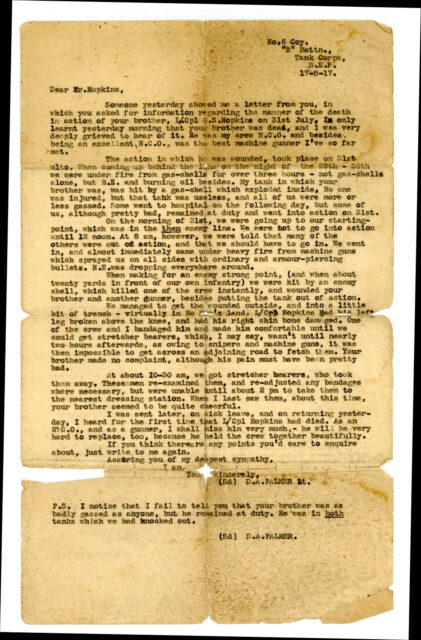A letter recently donated to The Tank Museum, poignantly arriving the week before Remembrance Sunday, offers a glimpse into the bravery and resilience of tank men facing the horrors of the First World War.

When the grieving brother of Lance Cpl. G.S. Hopkins wrote a letter, asking for information regarding how his brother had died, Commanding Officer Lt. D.A. Palmer was quick to respond with a detailed account of the final days of “the best machine gunner I’ve so far met.”
In his letter, dated August 17, 1917, Lt. Palmer provides a detailed account of the tank actions in which Lance Cpl. Hopkins was injured and later died.
After their tank was put out of action by a gas-shell, both Lance Cpl. Hopkins and Lt. Palmer resumed their duty in a second tank, which was hit by a shell the following day, causing Hopkins’ injuries. Palmer and another member of the crew bandaged Hopkins and made him comfortable.
“Your brother made no complaint, although his pain must have been pretty bad,” Lt. Palmer writes.
Lt. Palmer last saw Lance Cpl. Hopkins when he was taken to the nearest dressing station, and only heard later of his death.
“I was sent later, on sick leave, and on returning yesterday, I heard for the first time that L/Cpl Hopkins had died. As an N.C.O., and as a gunner, I shall miss him very much – he will be very hard to replace too, because he held the crew together beautifully,” he writes.
Lt. Palmer ends his letter inviting Mr. Hopkins to write again – “if there are any points you’d care to enquire about” – and signs off, “Assuring you of my deepest sympathy.”
This is followed by a postscript emphasizing Lance Cpl. Hopkin’s bravery: “P.S. I notice that I fail to tell you that your brother was as badly gassed as anyone, but he remained at duty. He was in both tanks which we had knocked out.”

Historian James Donaldson said in a press release:
“First-hand accounts of action from WWI are rare, and the fact that this letter dates from the early use of tanks, makes it an invaluable addition to the museum’s collection.
“It is fascinating, humbling and incredibly moving to read such a personal piece of correspondence. It really brings home the impact of a war often told in terms of large-scale losses on the individual soldier and their families, as well as their brothers in arms.”
More from us: The Tank Museum Keeps Christmas Tradition Alive
To learn more about the story of tanks and tank crews, visit The Tank Museum in Bovington, Dorset, or check out its website.
